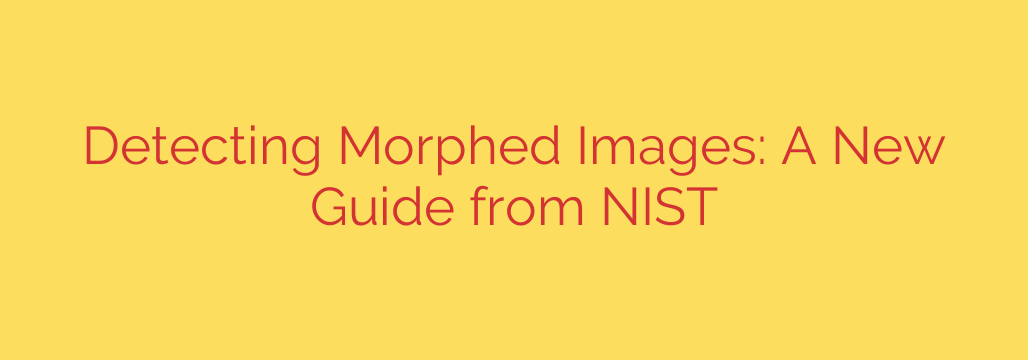
Is That Face Real? Unmasking the Growing Threat of Morphed Photos
In our increasingly digital world, your face is your password. From unlocking your phone to passing through airport security, facial recognition technology is everywhere. But what if the photo on your ID card wasn’t entirely yours? What if it was a seamless blend of your face and someone else’s? This isn’t science fiction; it’s a sophisticated security threat known as photo morphing, and it poses a significant risk to personal and national security.
A morphed photograph is a digital composite created by fusing the facial images of two or more people. The final product is a high-quality, believable portrait of a non-existent person. Frighteningly, this synthetic image often contains enough biometric data from each of the original individuals to fool both human inspectors and automated facial recognition systems.
The danger is clear: a single doctored ID, like a passport or driver’s license, could serve as a valid credential for multiple individuals. This opens the door for criminals or terrorists to share a single fraudulent identity, making it incredibly difficult to track their movements and activities across secure borders.
The Security Risk You Can’t See
The core challenge with morphed photos is their subtlety. Unlike clumsy photo editing, modern morphing techniques, often powered by artificial intelligence, produce images with no obvious signs of manipulation. The resulting face looks plausible and can easily pass a quick visual check.
When this doctored photo is submitted for a passport application, it becomes the official “ground truth” image stored in the chip. At a border checkpoint, the facial recognition system will compare the live traveler to this stored photo. Because the morphed image contains biometric information from both the traveler and their accomplice, the system is likely to register a successful match for either person.
This vulnerability undermines the very foundation of biometric security. It exploits the trust we place in identity documents by turning them into potential skeleton keys for illicit access.
A New Framework for Detecting Digital Doppelgangers
To combat this invisible threat, a new, more rigorous approach to detection is necessary. The focus is shifting from simply matching faces to actively searching for signs of manipulation within the photo itself. Two primary strategies have emerged as the front line of defense.
Differential Morph Detection: This method is used at points of verification, like an airport eGate. It works by comparing the photo on the identity document (e.g., from the passport chip) against a new, live photo of the person standing at the gate. Sophisticated algorithms analyze the two images for subtle inconsistencies that would not be present if the document photo were genuine. This “live vs. stored” comparison is a powerful tool for catching fraud in real-time.
Single-Image Morph Detection: This technique, also known as “no-probe” detection, doesn’t require a live image for comparison. Instead, it scrutinizes the document photo itself during the application or issuance process. The software is trained to identify the tiny, almost invisible digital artifacts and textural anomalies left behind by the morphing process. By analyzing the image file for forensic clues, this method can stop a fraudulent document from ever being created.
Measuring Success: Balancing Security and Convenience
Implementing new detection technology is only half the battle. We also need a reliable way to measure its effectiveness. For any morph detection system, performance hinges on striking a critical balance between two key metrics:
- The “Miss Rate”: This measures how often a morphed photo slips through the system undetected. A high miss rate represents a serious security failure. The goal is to get this number as close to zero as possible.
- The “False Alarm Rate”: This measures how often a completely legitimate photo is incorrectly flagged as a morph. A high false alarm rate creates delays, frustrates innocent travelers, and adds an unnecessary burden on security personnel.
Striking the right balance between catching every threat and avoiding false accusations is crucial for creating a security system that is both effective and user-friendly. Standardized testing frameworks are essential for helping organizations evaluate different software solutions and choose the one that best meets their security needs.
Actionable Security Tips for Organizations
As photo morphing technology becomes more accessible, organizations that rely on photo identification must act proactively.
- Audit Your Vulnerability: Assess whether your current identity verification systems are equipped to detect sophisticated morphing attacks. Standard facial recognition is often not enough.
- Implement Specialized Detection Software: Invest in technologies designed specifically for single-image or differential morph detection. Prioritize systems that have been rigorously tested against a wide range of morphing techniques.
- Strengthen Application Processes: The best time to catch a morphed photo is before an official document is ever issued. Enhance your vetting process with automated detection tools to analyze submitted photos.
- Stay Informed: The field of digital image manipulation is constantly evolving. Ensure your security teams stay current on the latest threats and the technologies developed to counter them.
The battle for identity security is moving to a new, more complex front. Morphed photos represent a hidden but potent threat, but with advanced detection methods and a commitment to rigorous testing, we can ensure that a face remains a reliable and unique key, not a shareable password.
Source: https://www.helpnetsecurity.com/2025/08/18/nist-guide-detect-morphed-images/








